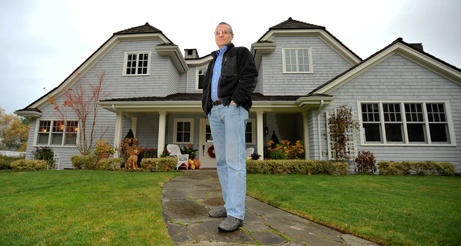Imagine, architect Robert Moore poses, living comfortably in a Northwest home that doesn’t have mechanical heating or air-conditioning units.
The Bainbridge resident, who has been designing residential buildings in the region for about 20 years, has decided to hitch his career wagon to just such a premise.
Moore has embraced the building of a “passive house,” a central European energy-saving building standard that has has been successful there because of its low-tech, cost-effective approach. Six such projects have been built in the U.S. in recent years, with another 15 now ready to be certified.
Essentially, a passive house (or multifamily units as is often the case in Europe) is a super-insulated, airtight structure that minimizes energy loss and maximizes passive energy gains. If done correctly, according to Passive House Institute US (est. 2007 in Urbana, Ill.), passive homes can use 90 percent less energy for heating than most houses.
As do the approximate 20,000 units now standing in Europe (mostly in Germany), passive homes that Moore and other designers want to build feature highly insulated walls, roofs and window (triple-paned) frames that allow air ducts and pumps to ventilate the homes’ natural heat so sufficiently that furnaces are no longer necessary in most cold climates.
The critical element is the involvement of the institute, a nonprofit that is modeled after its German counterpart. It controls the building standard by offering certification classes (for about $2,000) to people like Moore and then closely monitors each “passive” construction before anointing it worthy of its seal of approval.
Software analysis and documentation are also employed to ensure air is circulated properly, The final step is a blower door test that checks for leaks by depressurizing the house to detect spots where air sneaks in.
Moore is currently looking in north Kitsap County for “the perfect environment” on which to build a passive house that will serve as his model. While property is more expensive on the island, he hopes to build it here because “islanders are concerned about the environment” and involved in sustainability practices.
“I believe the passive house will really take off in the future as people become more interested in green building,” he said. “I’m trying to get ready for when the time comes.”
Moore estimates that passive homes may cost 3-to-5 percent more than standard houses because of the added expense for insulation and windows, but the expense is offset by the reduction in heating and energy costs.
“Passive houses are straightforward to build because most of the designs are uncomplicated – without a lot of unnecesary space.”
The institute’s co-founder, Katrin Klingenberg, who was involved in building passive homes in her native Germany, said the Pacific Northwest “is almost perfect” for the houses.
“It’s the climate (in the U.S.) that’s closest to the central European climate – less sun, but milder temperatures.”
Klingenberg said interest in passive houses is beginning to take off in part because the institute has trained about 75 consultants in the U.S., with another 80 are ready to be certified.
Moore said it’s difficult for some people to except the concept, “but it’s just a matter of the architect and builder proving that it works by demonstrating it and then monitoring each step as it’s built.”
Moore and many others are certain that it’s the home of the future.
Passive House Basics
1. Passive solar design leverages the sun’s energy by strategically lighting or shading the interior space .
2. Superinsulation includes the use of high R-values for walls, floors, ceilings that are thermally broken.
3. Advanced window technology features triple-glazed, argon-filled double low-e units with superinsulated frames.
4. Airtightness is critical to minimize the amount of heat or coolness that escapes the envelope.
5. Heat-recovery ventilator systems and earth-warming tubes provide a constant balance of fresh air.
6. Space heating minimizes the size of the heating components and maximizes internal heat gain from human and other sources.
7. Install efficient lighting and electrical appliances when possible.
For more information, call Robert Moore at 842-6366 or email info@passivehouse.us


